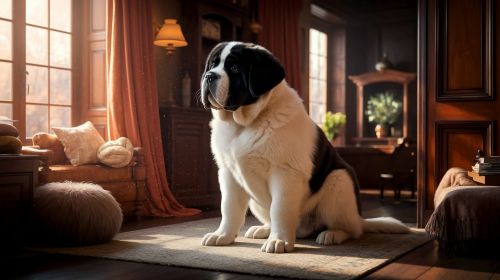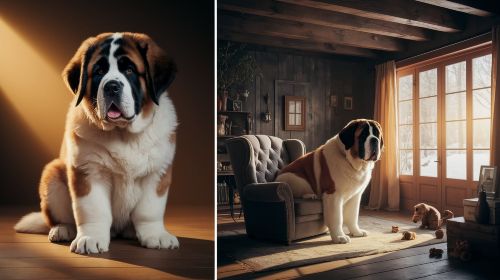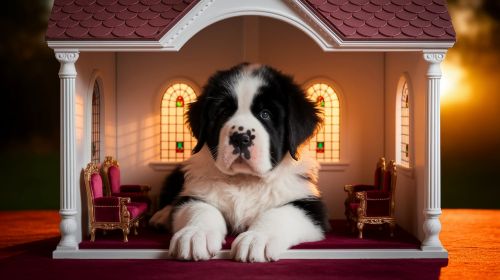Introduction
When you bring home a Saint Bernard puppy, you feel enthusiastic and happy. You can watch them grow to be one of the biggest breeds with very loving hearts. In this guide, you’ll learn about their size growth and living space requirements.
You will see how tall they can go and how heavy they will get and how fast the growth will occur. You will also learn the way you can organize space in your home for this giant breed. By the end of it, you will know whether or not your home can handle a Saint Bernard.
When you look at dogs, you see how different they are. The German Shepherd has courage and can work in police or military jobs. The Cavalier King Charles Spaniel has charm and will fit well in a family. And the Golden Retriever has love for play and people, which makes it a joy to raise.
Understanding Saint Bernard Size Growth
Puppy to Adult Development
At first a puppy of St. Bernard is small. Slowly it grows into what seems like rapid growth in months. As early as six months of age, they already can weigh in at 70 pounds. Their bones get bigger quick, and you will see this constant change.
At the age of one year, the Saint Bernard may achieve near-adult height. Weight increasing and muscle development continues. The majority of achieve full maturation between the ages of 18 to 24 months. However, they can grow until the age of three.
Average Height and Weight
An adult male Saint Bernard can have a weight of 140–180 pounds. Females typically weigh 120–140 pounds. Males are 28–30 inches in height and females are 26–28 inches in height. This fact alone makes them one of the most heavy dog breeds in the world.
The size is not only related to the height. Their bones are heavy, their head big and their chest is wide. Furnishings and small space need to be expected to look smaller as they mature.
Growth Stages Of A Saint Bernard
Early Puppy Stage (0–6 Months)
During this period, rapid weight gain is observed. Puppies can gain 3–5 pounds each week. Their appetite increases and they will be fed well-balanced meals. This time period requires careful oversight so that bone stress is not produced.
Juvenile Stage (6–12 Months)
Here, the puppy looks like an ungainly adolescent. Legs appear to be long, and movements seem clunky. Rapid growth changes are to be expected. Weight gets gradually increased, and muscular development takes place.
Adolescent Stage (12–18 Months)
Growth slows down a little. The body becomes heavier, the head becomes round. By the time, your Saint Bernard already has the stature of an elephant. Still, they are energetic and playful – they are just not wriggly puppies.
Full Adult Stage (18–36 Months)
Now the dog is fully mature. The body is slumberous, the chest deep and the structure sound. The classic Saint Bernard look can now be seen; big but gentle.

Now think about size and space. The Saint Bernard has a giant body and will need more room than most homes give. The Mini Bernedoodle can live in an apartment if you train it well. And the Dachshund has health risks, but you can manage them with care.
Living Space Requirements For A Giant Breed
Indoor Space
It is necessary to arrange sufficient space in your home. A Saint Bernard won’t be able to move around with ease in a small apartment. They require large corridors, open areas and room to stretch.
Although they remain calm indoors, they lack space given their size. A dog bed will have a larger size than only one mattress. Water and food bowls also take up more room.
Outdoor Space
A yard is not always necessary, but it does help. A Saint Bernard enjoys brief bouts of play in the outdoors. During the cooler weather, they can sit outside. However, you must have a shady and fenced area.
Neither do they require the same activity level as a Husky or German Terminal. However, access to outdoor space promotes joint health and mental stimulation.
The Impact Of Size On Household Arrangements
Furniture And Movement
Chairs and tables will fly around the room while your Saint Bernard walks through your home. Their tail alone has the ability to knock small objects down. It will need strong furniture and safe walking areas.
Flooring And Safety
Hardwood floors may lead to slipping. meningiomas of the brain Joints can be protected by rugs or mats. The leg stress that a Saint Bernard’s weight places on legs is the reason that it’s better with non-slip flooring.
Sleeping Arrangements
They shall never fit on a small dog bed. Oversize orthopedic beds are offered by most owners. You might also let them sit on couches but this can be wearing on the furniture.
Nutrition And Growth Control
Balanced Diet Needs
Saint Bernards grow quickly, and an unhealthy diet may damage joints. You need to feed large breed puppy food of high quality. This food is responsible for calcium and phosphorous levels for proper bone growth.
Overfeeding can result in obesity, which is a source of stress on joints. Limited portions provide for stable and safe growth.
Feeding Schedule
- Puppies: 3–4 meals per day.
- Adolescents: 2–3 meals per day.
- Adults: 2 meals per day.
Avoid free-feeding. Bloat is a serious stomach disorder that occurs in large breeds. Post-prandial rest must always be allowed.
Exercise And Space Connection
Indoor Activity
A Saint Bernard does not require constant running. Indoor games and play can keep them satisfied. They should be able to turn, stretch, and move around without touching any objects.
Outdoor Activity
Daily walks are necessary. These walks need not be long but should be regular. If there is grass or open space nearby, this is easier. Space to play fetch or play freely without any trouble.
Social And Family Space Needs
With Children
Saint Bernards are referred to as gentle giants. They are patient and calm around children. However, their size makes it possible for accidents to occur. You must supervise playtime.
With Other Pets
They can live with other dogs such as Beagles or Golden Retrievers. They are social, but they need introductions. They are typically small, and as such, smaller breeds such as a Shih Tzu or a Pomeranian may be overwhelmed in the beginning.
Pros And Cons Of Owning A Saint Bernard
Just for clarity, here is a simple table:
| Pros | Cons |
|---|---|
| Gentle and loving with families | Very large size requires big space |
| Calm indoors and not overly active | Heavy drooling and shedding |
| Protective and loyal | High food and healthcare costs |
| Good with children and pets | Shorter lifespan compared to smaller breeds |

Training and health always matter. Rottweiler puppies have to learn early so they grow up confident. The Goldendoodle has brains and will learn fast if you stay consistent. And a dog DNA test can give you facts about breeds and health so you know what to expect.
Table Of Growth Stages
| Age | Height Range | Weight Range |
|---|---|---|
| 3 Months | 15–18 inches | 35–45 lbs |
| 6 Months | 22–24 inches | 70–90 lbs |
| 12 Months | 26–28 inches | 110–140 lbs |
| 24 Months | 28–30 inches | 140–180 lbs |
Expert Insight On Living With Giants
Saint Bernards require attention to joints, veterinarians say. For large breeds, the American Kennel Club (AKC) recommends large breed specific diets. You can find out more about canine nutrition through credible places like AVMA.org.
Breeders also recommend crate training, but in extra-large crates. A Saint Bernard will not work in a Beagle or Caviezel crate. Thoughtfully spending space now will help avoid stress later.
Internal Link For Further Reading
If you want to learn more about various breeds and what they require, then Dog Breeds Online contains detailed guides on them.
Apartment Living With A Saint Bernard
Is Apartment Living Possible?
Many people want to know if it is possible to raise a Saint Bernard in an apartment. Yes, but with the help of hard work. They take a lot of physical activity; they need disciplined training; they have to be provided with spaces carefully.
Practical Tips For Apartments
- Use baby gates for access control.
- Invest in orthopedic beds not crates.
- Provide cooling mats during the summer months.
- Teaching the use of the elevator calmly.
Climate And Space Considerations
Heat Sensitivity
Saint Bernards are not wear for hot weather. Their thick coats trap heat. At higher altitudes, in warmer climates, air conditioning is a must as well as role shaded gardens.
Cold Weather Comfort
They thrive in cold weather. Snow play brings joy to them. However, you still have to give a dry indoor environment. Left untreated wet coats can lead to development of skin conditions.
Costs Related To Size And Space
Food Expenses
Large dogs eat more. Monthly food costs can reach $100–$150. Premium diets are more expensive but avoid health issues.
Healthcare Expenses
Hip dysplasia, heart problems and bloat are common. The reason for the higher costs of treating and insuring an animal is their size. Care costs average more than $1,000 a year.
Housing Adjustments
You may need:
- Larger vehicles for travel.
- Bigger crates and beds.
- Illegal, better leashes and collars.
And while these costs are considerable, they are essential to living safely.
Training For Large Spaces
Obedience Training
Training early is key. A Saint Bernard puppy can still be carried about though. They become uncontrollable when they reach a weight of 100 pounds. Basic commands: sit, stay, and heel must be learned.
Socialization
Exposure them to various environments. Confidence is gained by meeting other dogs such as Golden Retrievers or Huskies. Social training makes sure they will conduct well in small or crowded spaces.
Grooming And Cleaning Space
Shedding Control
Saint Bernards shed heavily. Corpuscles of hair are found on the floor, the furniture, and clothing. Daily brushing makes the loose hair decrease. Vacuuming is a daily assignment in communal living spaces.
Drool And Cleanliness
Drool is part and parcel living with this breed. Drool marks may be present on the floor, walls and some even on the ceiling of rooms. Towels should be available in each room. This habit impacts on cleaning practices in nooks and crannies.
Best Practices For Managing Living Space
Create Dog Zones
Set a single large room as a dog area (or set up a fenced area on the backyard). These are where you will put the bed, bowls and toys. This helps to keep the rest of the house cleaner.
Use Vertical Storage
Saint Bernards cannot be used as trick-or-treats like cats can. But you can put toys and supplies away in shelves and such. This also leaves the floor free for movement.
Safety Adjustments
- Secure electrical cords.
- Surrounding furniture with sharp corners should be eliminated.
- Although, if you develop joint problems, protect stairs with a cover.
Case Study: Family With A Saint Bernard
A Chicago family tells their story. Noem and Rafield as they do in two-bedroom apartment with a St. Bernard. They use the large balcony area for outdoor. Exercise requirements are met with daily walks.
They moved furniture to provide ways to get through. They bought heavy duty vacuum cleaners, cooling mats. With these measures in place, they can go about living the inside life with this gentle giant.
Comparison With Other Breeds
Saint Bernard vs Beagle
Beagles are small and active and can fit in an apartment. Saint Bernards require less energy and more space.
Saint Bernard vs Golden Retriever
Golden Retrievers take to running and playing in the water. Saint Bernards like to play less time but like more room to sleep.
Saint Bernard vs Pomeranian
Pomeranians are suitable for any environment, even a small house. A Saint Bernard will need precise space planning and high capacity equipment.
FAQs About Saint Bernard Size And Space
1. How much room does a Saint Bernard require indoors?
They will require a medium space for living room in order to move around comfortably. Open layouts are most appropriate for their large bodies.
2. Can a Saint Bernard live in a small apartment?
Yes but you have to promise exercising daily and making adaptations at home. Space has to be made for movement.
3. Do Saint Bernards need a yard?
A yard helps, but is not necessary. Back yards are replaced by walks, and game time is replaced by controlled play time.
4. St. Bernard: does the dog grow to size furniture?
Yes, most will. You will need oversized beds, durable couches and bigger feeding points.
5. How do I keep my Saint Bernard comfortable in hot climates?
Cooling mats, air conditioning equipment and shaded areas. Avoid exercise during peak heat hours.

Conclusion
Growth in size as well as the living space requirements of a Saint Bernard require planning, commitment, and adaptation. You have to get ready for their quick growth, indoor adjustments and special needs. With proper training they can live happily in houses or apartments.
They are a source of love, loyalty, and companionship to your family. While you are used to some of the ramifications of their size can be a shock at first, the pleasure of living with a Saint Bernard is well worth the change.
Visit Dog Breeds Online to read more guides regarding the proper care of dogs, their training, and other useful information regarding different breeds.
Call To Action
If you are going to have a Saint Bernard, start gathering together your space now. Change the furniture around, cool cooling systems, and invest in essential large breed things. Your future gentle giant will be thankful.